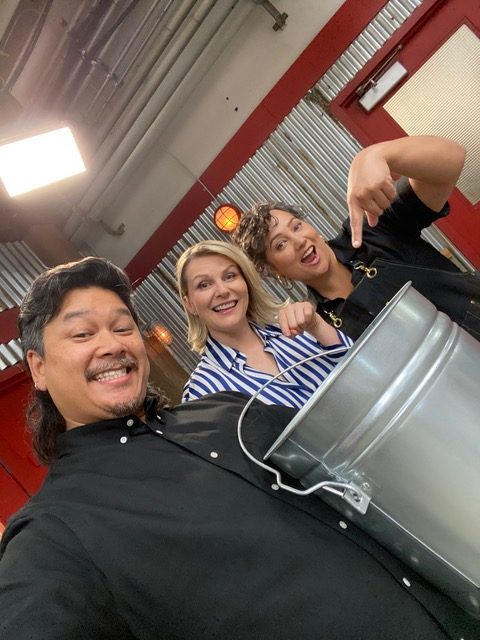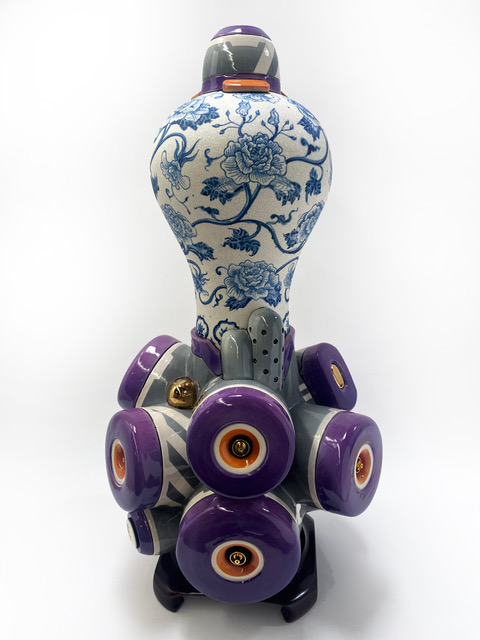The Vancouver-based artist and ceramist is a celebrity judge on CBC’s The Great Canadian Pottery Throwdown.


Vancouver-born NSCAD alumni, Brendan Tang (he/they), enjoys working in their home city, but his studies took him to different landscapes like Edwardsville for his MFA at Southern Illinois University, and to NSCAD University for his BFA.
“What drew me to the East Coast was the great studio-based, practice-based program at NSCAD,” they say.
Now an instructor at Emily Carr University, Tang works with multiple mediums—including a life-size Ford F150 truck constructed out of watercolour paper—but is best known for his sculptural ceramics. This is part of the reason he ended up as a judge on the inaugural season of CBC’s The Great Canadian Pottery Throwdown, executive produced by recreational potter and actor Seth Rogen.
How did you end up in Halifax from all the way across the country?
Most of my education has been looking for a studio-based program. Academia means a lot of reading and philosophy, but I was looking for a program that would meet my technical making needs. When I went to NSCAD to visit, I met Walter Ostrom and immediately, that East Coast welcome was there— he’s such an open, generous man.
I ran into him at the Art Gallery of Nova Scotia and he said, “Come down to Ceramics [at NSCAD] and I’ll get someone to show you around.” That open-door vibe that is so great about the East Coast.
You talk about belonging to “the remix generation,” what does that mean to you and how does it apply to your work?
A lot of my training comes out of that late-90s post-modernism vibe, a deconstruction/reconstruction kind of aesthetic; that really informed my practice. As a young person I was emulating a lot of pop culture—it’s almost like I understood it through a lens of popular culture, hip hop, EDM. I feel in a lot of ways, my work approaches it that way. Reprocesses it and remixes it.
I feel like back in my day, finding trends was a way of defining yourself and finding the communities you wanted to be a part of. When I came out to NSCAD in the late 90s, rave culture was really big and that was such a wonderful experience as part of my education. It was a way of finding your people.
You work with lots of materials but what is it about ceramics that you connect to?
Working with my hands is a draw. I like the order of a process—I find something delightfully predictable about knowing what you have to do next. It’s a little more sophisticated than a Sudoku puzzle, but there’s joy in completing it.
There’s a flow state about these things that’s satisfying on a mental level, getting into that zone. The process gives you a structure, the space created with the process helps me figure out the world. I’m always in awe of painters—there’s a process but it’s also so amorphous. Ceramics has a timeline.
A lot of ceramicists dive into the alchemy, but I’m so controlling of the process of how I’m carving things and painting things. Where there’s more improvisation is how I do my compositions or modelling things, there’s space to do the free-form jazz sort of thing. So, it’s less ‘gifts from the kiln’ and more ‘that’s exactly what I wanted.’
Competition shows usually have a template—there’s the nice judge, the mean one, the wild card. How did you fit in at The Great Canadian Pottery Throwdown?
I could just be myself, which is a big ceramic nerd!
We all know these competition shows and the kinds of characters that are part of them. During COVID, The Great Canadian Baking Show was my comfort show, and I knew it wasn’t the backstabbing, teaching through cruelty and shame that a lot of competition shows tend to be.
Essentially the goal was to have the people compete with themselves and be the best they could be. Basically, the rising tide lifts all boats approach. I teach from a place of care and I’m genuinely interested in what these people are doing. They were into that vibe.
Are you getting recognized?
I haven’t been recognized yet, but I did cut my mullet off so maybe I’m incognito. I miss that beautiful mane.
My Instagram followers are definitely going up though, which is a hoot, but I don’t know what to do about this. Art school in the 90s did not prepare me for social media management.
